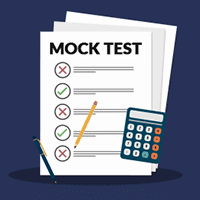CAT Exam > CAT Questions > Q. A dishonest shopkeeper has two weighing st...
Start Learning for Free
Q. A dishonest shopkeeper has two weighing stones one is heavier and the other is lighter, for his weight balance. While purchasing 10kg of goods, he puts the heavier stone on one side and the goods on the other. While selling 10kg of goods, he puts the lighter stone on one side and the goods on the other. If he decides to sell his goods at 30% above the cost price and gets an overall gain of 55.55%, then find the value by which one side of the balance is heavier than the other (in grams).?
Most Upvoted Answer
Q. A dishonest shopkeeper has two weighing stones one is heavier and t...
Analysis:
To solve this problem, we need to understand how the dishonest shopkeeper manipulates the weighing stones to deceive his customers and make a profit.
Given Information:
- Shopkeeper uses a heavier stone while purchasing goods and a lighter stone while selling goods.
- Shopkeeper sells goods at 30% above the cost price.
- Shopkeeper gains 55.55% overall.
Solution:
1. Let's assume the cost price of 10kg of goods is Rs.100.
2. Selling price after a 30% markup = Rs.100 + 30% of Rs.100 = Rs.130.
3. Overall gain = Selling price - Cost price = Rs.130 - Rs.100 = Rs.30.
4. Gain percentage = (Overall gain / Cost price) * 100 = (Rs.30 / Rs.100) * 100 = 30%.
5. As the shopkeeper gains 55.55%, the weight difference between the stones must be 55.55% of the total weight of goods (10kg).
Calculations:
- Weight of goods = 10kg = 10,000 grams.
- Weight difference = 55.55% of 10,000 grams = 5,555 grams.
Answer:
The value by which one side of the balance is heavier than the other is 5,555 grams. This weight difference allows the shopkeeper to deceive customers and make a profit by manipulating the weighing stones.
To solve this problem, we need to understand how the dishonest shopkeeper manipulates the weighing stones to deceive his customers and make a profit.
Given Information:
- Shopkeeper uses a heavier stone while purchasing goods and a lighter stone while selling goods.
- Shopkeeper sells goods at 30% above the cost price.
- Shopkeeper gains 55.55% overall.
Solution:
1. Let's assume the cost price of 10kg of goods is Rs.100.
2. Selling price after a 30% markup = Rs.100 + 30% of Rs.100 = Rs.130.
3. Overall gain = Selling price - Cost price = Rs.130 - Rs.100 = Rs.30.
4. Gain percentage = (Overall gain / Cost price) * 100 = (Rs.30 / Rs.100) * 100 = 30%.
5. As the shopkeeper gains 55.55%, the weight difference between the stones must be 55.55% of the total weight of goods (10kg).
Calculations:
- Weight of goods = 10kg = 10,000 grams.
- Weight difference = 55.55% of 10,000 grams = 5,555 grams.
Answer:
The value by which one side of the balance is heavier than the other is 5,555 grams. This weight difference allows the shopkeeper to deceive customers and make a profit by manipulating the weighing stones.
Attention CAT Students!
To make sure you are not studying endlessly, EduRev has designed CAT study material, with Structured Courses, Videos, & Test Series. Plus get personalized analysis, doubt solving and improvement plans to achieve a great score in CAT.

|
Explore Courses for CAT exam
|

|
Q. A dishonest shopkeeper has two weighing stones one is heavier and the other is lighter, for his weight balance. While purchasing 10kg of goods, he puts the heavier stone on one side and the goods on the other. While selling 10kg of goods, he puts the lighter stone on one side and the goods on the other. If he decides to sell his goods at 30% above the cost price and gets an overall gain of 55.55%, then find the value by which one side of the balance is heavier than the other (in grams).?
Question Description
Q. A dishonest shopkeeper has two weighing stones one is heavier and the other is lighter, for his weight balance. While purchasing 10kg of goods, he puts the heavier stone on one side and the goods on the other. While selling 10kg of goods, he puts the lighter stone on one side and the goods on the other. If he decides to sell his goods at 30% above the cost price and gets an overall gain of 55.55%, then find the value by which one side of the balance is heavier than the other (in grams).? for CAT 2024 is part of CAT preparation. The Question and answers have been prepared according to the CAT exam syllabus. Information about Q. A dishonest shopkeeper has two weighing stones one is heavier and the other is lighter, for his weight balance. While purchasing 10kg of goods, he puts the heavier stone on one side and the goods on the other. While selling 10kg of goods, he puts the lighter stone on one side and the goods on the other. If he decides to sell his goods at 30% above the cost price and gets an overall gain of 55.55%, then find the value by which one side of the balance is heavier than the other (in grams).? covers all topics & solutions for CAT 2024 Exam. Find important definitions, questions, meanings, examples, exercises and tests below for Q. A dishonest shopkeeper has two weighing stones one is heavier and the other is lighter, for his weight balance. While purchasing 10kg of goods, he puts the heavier stone on one side and the goods on the other. While selling 10kg of goods, he puts the lighter stone on one side and the goods on the other. If he decides to sell his goods at 30% above the cost price and gets an overall gain of 55.55%, then find the value by which one side of the balance is heavier than the other (in grams).?.
Q. A dishonest shopkeeper has two weighing stones one is heavier and the other is lighter, for his weight balance. While purchasing 10kg of goods, he puts the heavier stone on one side and the goods on the other. While selling 10kg of goods, he puts the lighter stone on one side and the goods on the other. If he decides to sell his goods at 30% above the cost price and gets an overall gain of 55.55%, then find the value by which one side of the balance is heavier than the other (in grams).? for CAT 2024 is part of CAT preparation. The Question and answers have been prepared according to the CAT exam syllabus. Information about Q. A dishonest shopkeeper has two weighing stones one is heavier and the other is lighter, for his weight balance. While purchasing 10kg of goods, he puts the heavier stone on one side and the goods on the other. While selling 10kg of goods, he puts the lighter stone on one side and the goods on the other. If he decides to sell his goods at 30% above the cost price and gets an overall gain of 55.55%, then find the value by which one side of the balance is heavier than the other (in grams).? covers all topics & solutions for CAT 2024 Exam. Find important definitions, questions, meanings, examples, exercises and tests below for Q. A dishonest shopkeeper has two weighing stones one is heavier and the other is lighter, for his weight balance. While purchasing 10kg of goods, he puts the heavier stone on one side and the goods on the other. While selling 10kg of goods, he puts the lighter stone on one side and the goods on the other. If he decides to sell his goods at 30% above the cost price and gets an overall gain of 55.55%, then find the value by which one side of the balance is heavier than the other (in grams).?.
Solutions for Q. A dishonest shopkeeper has two weighing stones one is heavier and the other is lighter, for his weight balance. While purchasing 10kg of goods, he puts the heavier stone on one side and the goods on the other. While selling 10kg of goods, he puts the lighter stone on one side and the goods on the other. If he decides to sell his goods at 30% above the cost price and gets an overall gain of 55.55%, then find the value by which one side of the balance is heavier than the other (in grams).? in English & in Hindi are available as part of our courses for CAT.
Download more important topics, notes, lectures and mock test series for CAT Exam by signing up for free.
Here you can find the meaning of Q. A dishonest shopkeeper has two weighing stones one is heavier and the other is lighter, for his weight balance. While purchasing 10kg of goods, he puts the heavier stone on one side and the goods on the other. While selling 10kg of goods, he puts the lighter stone on one side and the goods on the other. If he decides to sell his goods at 30% above the cost price and gets an overall gain of 55.55%, then find the value by which one side of the balance is heavier than the other (in grams).? defined & explained in the simplest way possible. Besides giving the explanation of
Q. A dishonest shopkeeper has two weighing stones one is heavier and the other is lighter, for his weight balance. While purchasing 10kg of goods, he puts the heavier stone on one side and the goods on the other. While selling 10kg of goods, he puts the lighter stone on one side and the goods on the other. If he decides to sell his goods at 30% above the cost price and gets an overall gain of 55.55%, then find the value by which one side of the balance is heavier than the other (in grams).?, a detailed solution for Q. A dishonest shopkeeper has two weighing stones one is heavier and the other is lighter, for his weight balance. While purchasing 10kg of goods, he puts the heavier stone on one side and the goods on the other. While selling 10kg of goods, he puts the lighter stone on one side and the goods on the other. If he decides to sell his goods at 30% above the cost price and gets an overall gain of 55.55%, then find the value by which one side of the balance is heavier than the other (in grams).? has been provided alongside types of Q. A dishonest shopkeeper has two weighing stones one is heavier and the other is lighter, for his weight balance. While purchasing 10kg of goods, he puts the heavier stone on one side and the goods on the other. While selling 10kg of goods, he puts the lighter stone on one side and the goods on the other. If he decides to sell his goods at 30% above the cost price and gets an overall gain of 55.55%, then find the value by which one side of the balance is heavier than the other (in grams).? theory, EduRev gives you an
ample number of questions to practice Q. A dishonest shopkeeper has two weighing stones one is heavier and the other is lighter, for his weight balance. While purchasing 10kg of goods, he puts the heavier stone on one side and the goods on the other. While selling 10kg of goods, he puts the lighter stone on one side and the goods on the other. If he decides to sell his goods at 30% above the cost price and gets an overall gain of 55.55%, then find the value by which one side of the balance is heavier than the other (in grams).? tests, examples and also practice CAT tests.

|
Explore Courses for CAT exam
|

|
Suggested Free Tests
Signup for Free!
Signup to see your scores go up within 7 days! Learn & Practice with 1000+ FREE Notes, Videos & Tests.























